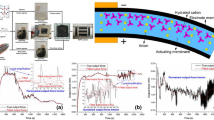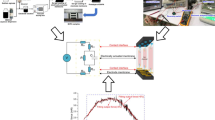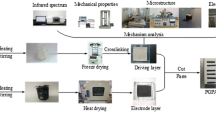Abstract
This study focuses on investigating a novel category of paper actuators, aiming to attain a favorable equilibrium between substantial electrically actuated force and extended service lifetime (Ts) for the soft electric-responsive artificial muscle. Consequently, the present research has developed an Electro-responsive Biomass Paper Actuator (ERBPA) utilizing calcium alginate hydrogel, employing absolute ethanol (CH3CH2OH) as the slow-release agent, through a straightforward and viable preparation procedure. Moreover, a comprehensive investigation was carried out on the electro-mechano-chemical behaviors and strengthening mechanism of the ERBPA with varying volume fractions of CH3CH2OH, under the electrical actuation of 4 V DC voltage. The experimental findings revealed a gradual decrease in the density of electrically actuated force, elastic modulus, and yield strength with the increasing volume fraction of CH3CH2OH. Specifically, at a volume fraction of 30%, these properties reached their respective minimum values of approximately 15.152 mN/g, 6.5 MPa, and 0.0999 MPa. In contrast to the internal resistance (Rg) of the ERBPA, the specific capacitance (Cp) and the Ts exhibited an initial improvement followed by a reduction, while the rise time (Tr) demonstrated a positive correlation with the volume fraction of CH3CH2OH but a negative correlation with the reaction velocity (Vf). Specifically, at a volume fraction of 25%, Cp, Ts and Tr reached their maximum values of 96.2 mF/g, 1287 s, and 170 s, respectively, whereas Rg and Vf attained their minimum values of 2.39 Ω and 0.044 mN/g·s, respectively. The slow-release effect of CH3CH2OH inherently contributed to the protection of certain free Ca2+ ions, thereby causing a gradual and consistent coordination process with sodium alginate molecules. This, in turn, greatly enhanced the internal structure of ERBPA, resulting in exceptional Ts stability and operational performance.










Similar content being viewed by others
Data availability
Not applicable.
Code availability
Not applicable.
References
Asyraf MRM, Ishak MR, Syamsir A, Nurazzi NM, Sabaruddin FA, Shazleen SS, Norrrahim MNF, Rafidah M, Ilyas RA, Rashid MZA, Razman MR (2022) Mechanical properties of oil palm fibre-reinforced polymer composites: a review. J Mater Res Technol 17(4):1–11. https://doi.org/10.1016/j.jmrt.2021.12.122
Bar-Cohen Y (2006) Biomimetic actuators using electroactive polymers (EAP) as artificial muscles. J Adv Mater-Covina 38(4):1–7. https://doi.org/10.2514/2.3902
Bar-Cohen Y (2008) Bionic humans using EAP as artificial muscles reality and challenges. Int J Adv Robot Syst 1(1):21. https://doi.org/10.5772/5813
Bass PS, Zhang L, Cheng ZY (2017) Time-dependence of the electromechanical bending actuation observed in ionic-electroactive polymers. J Adv Dielectr 7(02):1720002. https://doi.org/10.1142/S2010135X17200028
Chen W, Yu Z, Pang J, Yu P, Tan G, Ning C, Bernardo E (2017) Fabrication of biocompatible potassium sodium niobate piezoelectric ceramic as an electroactive implant. Materials 10(4):345. https://doi.org/10.3390/ma10040345
Chen J, Pakdel E, Xie W, Sun L, Xu M, Liu Q, Wang D (2020a) High-performance natural melanin/poly(vinyl alcohol-co-ethylene) nanofibers/pa6 fiber for twisted and coiled fiber-based actuator. Adv Fiber Mater 2(3):64–73. https://doi.org/10.1007/s42765-020-00036-w
Chen Y, Zhao H, Mao J, Chirarattananon P, Helbling EF, Hyun NSP, Clarke DR, Wood RJ (2020b) Controlled flight of a microrobot powered by soft artificial muscles. Nature 575(7782):324–329. https://doi.org/10.1038/s41586-019-1737-7
Chen W, Gao J, Ma J (2022) Research progress of sodium alginate composite hydrogel. J Beijing Institute Fashion Technol (Nat Sci Ed) 42(4):1–8. https://doi.org/10.16454/j.cnki.issn.1001-0564.2022.04.014
Dong Y, Yeung KW, Tang CY, Law WC, Tsui GCP, Xie X (2021) Development of ionic liquid-based electroactive polymer composites using nanotechnology. Nanotechnol Rev 10(1):99–116. https://doi.org/10.1515/ntrev-2021-0009
Envelope B, Wietlik W, Froelich A (2022) Sodium alginate as a pharmaceutical excipient: novel applications of a well-known polymer. J Pharm 111(5):1250–1261. https://doi.org/10.1016/j.xphs.2021.12.024
Huang L, Zhu P, Liu J, Sui S, Dong C, Huang Y (2017) Effect of ethanol content on structure and performances of alginic blended films in coagulation bath. Printing and Dyeing Auxiliaries 34(3):1–4. https://doi.org/10.3969/j.issn.1004-0439.2017.03.008
Khan M, Li T, Hayat A, Zada A, Ali T, Uddin L, Hayat A, Khan M, Ullah A, Hussain A, Zhao T (2021) A concise review on the elastomeric behavior of electroactive polymer materials. Int J Energ Res 45(10):14306–14337. https://doi.org/10.1002/er.6747
Li Y (2000) Comparison of a few commonly used methods in the determination of polymer crystal degree. J Shenyang Jianzhu Univ Nat Sci 16(4):269–271. https://doi.org/10.3321/j.issn:1671-2021.2000.04.009
Li J, Chee HL, Chong YT, Chan BQY, Xue K, Lim PC, Loh XJ, Wang FK (2022) Hofmeister effect mediated strong PHEMA-gelatin hydrogel actuator. ACS Appl Mater Interfaces 14(20):23826–23838. https://doi.org/10.1021/acsami.2c01922
Liang FF (2019) Discussion on analysis and detection technology based on polymer materials. China New Technol New Products 14:19–20. https://doi.org/10.13612/j.cnki.cntp.2019.14.011
Liu L, Wang F, Chen Z, Wei R, Zhang M (2018) Effect of Ca2+ crosslinking treatment on water absorption and corrosion rate of polyvinyl alcohol/sodium alginate hydrogel. China Sci Paper 13(18):2098–2103
Liu Y, Liu Z, Liang Y (2023) Research progress of ionic electroactive polymer actuators. Polym Bull 36(1):1–20. https://doi.org/10.14028/j.cnki.1003-3726.2023.01.003
Luo Z, Li W, Yan J, Sun J (2022) Roles of ionic liquids in adjusting nature of ionogels: a mini review. ADV Funct Mater 32(32):2203988. https://doi.org/10.1002/adfm.202203988
Mirvakili SM, Hunter IW (2018) Artificial muscles: mechanisms, applications, and challenges. Adv Mater 30(6):1–28. https://doi.org/10.1002/adma.201704407
SeeYao W, Weng Y, Catchmark J (2020) Improved cellulose X-Ray diffraction analysis using Fourier series modeling. Cellulose 27:5563–5579. https://doi.org/10.1007/s10570-020-03177-8
Shaikh MAJ, Alharbi KS, Almalki WH, Imam SS, Albratty M, Meraya AM, Alzarea SL, Kazmi L, Al-Abbasi FA, Afzal O, Altamimi ASA, Singh Y, Singh SK, Dua K, Gupta G (2022) Sodium alginate based drug delivery in management of breast cancer. Carbohyd Polym 292:119689. https://doi.org/10.1016/j.carbpol.2022.119689
Sun T (2022) Study on energy saving thermal coupling technology of absolute ethanol. Jiangxi Chem Industry 4:68–71. https://doi.org/10.14127/j.cnki.jiangxihuagong.2022.04.017
Sun JY, Zhao X, Illeperuma WRK, Chaudhuri O, Oh KH, Mooney DJ, Vlassak JJ, Suo Z (2012) Highly stretchable and tough hydrogels. Nature 489:133–136. https://doi.org/10.1038/nature11409
Yang J, Yao J, Guan S (2020) Enhanced electroresponsive and electrochemical properties of the biological gel artificial muscle prepared by sodium alginate and carboxylated chitosan. Sensor Actuat B-Chem 322(3):1–11. https://doi.org/10.1016/j.snb.2020.128526
Yang J, Yao J, Wang S (2022) Electromechanical response performance of a reinforced biomass gel artificial muscle based on natural polysaccharide of sodium alginate doped with an ionic liquid for micro-nano regulation. Carbohyd Polym 275:1–11. https://doi.org/10.1016/j.carbpol.2021.118717
Yang J, Yu T, Yao J, Wang S, Wei K (2023) Application of MWCNT-SA based sol-gel coatings to enhance the electrically-actuated performance of biomass hydrogel paper actuators. Cellulose 30:1741–1757. https://doi.org/10.1007/s10570-022-04992-x
Yao S, Sun X, Ye L, Liang H (2022) A strong and tough gelatin/polyvinyl alcohol double network hydrogel actuator with superior actuation strength and fast actuation speed. Soft Matter 18:9197–9204. https://doi.org/10.1039/D2SM01342H
Zhang C, Zheng D, Song GL, Guo Y, Liu M, Kia H (2019) Influence of microstructure of carbon fibre reinforced polymer on the metal in contact. J Mater Res Technol 9(1):1–34. https://doi.org/10.1016/j.jmrt.2019.10.085
Acknowledgments
We express our gratitude to the editorial team of Home for Researchers (www.home-for-researchers.com) for providing language editing services.
Funding
This research is financially supported by National Natural Science Foundation of China (No. 52205301) and the Science and Technology Innovation Development Project of Jilin City (Grant No. 20230103020).
Author information
Authors and Affiliations
Contributions
All authors contributed to the study conception and design. Material preparation, data collection and analysis were performed by JY, SW, JY, ZJ, MF, TY, and KW. The first draft of the manuscript was written by JY and SW, and all authors commented on previous versions of the manuscript. All authors read and approved the final manuscript.
Corresponding author
Ethics declarations
Conflict of interest
The authors have no conflicts of interest to declare that are relevant to the content of this article.
Additional information
Publisher's Note
Springer Nature remains neutral with regard to jurisdictional claims in published maps and institutional affiliations.
Rights and permissions
Springer Nature or its licensor (e.g. a society or other partner) holds exclusive rights to this article under a publishing agreement with the author(s) or other rightsholder(s); author self-archiving of the accepted manuscript version of this article is solely governed by the terms of such publishing agreement and applicable law.
About this article
Cite this article
Yang, J., Wang, S., Yao, J. et al. Slow-release effect of absolute ethanol on electro-mechano-chemical behavior and strengthening mechanism of an electric-responsive biomass paper actuator based on calcium alginate hydrogel. Cellulose 31, 463–478 (2024). https://doi.org/10.1007/s10570-023-05630-w
Received:
Accepted:
Published:
Issue Date:
DOI: https://doi.org/10.1007/s10570-023-05630-w




